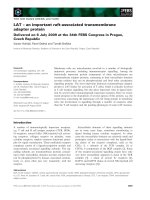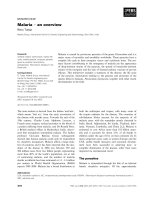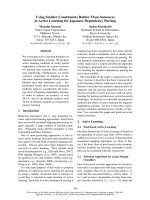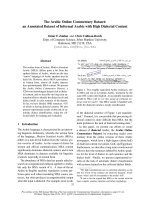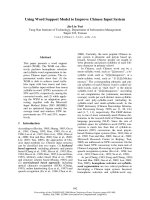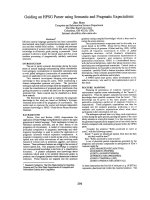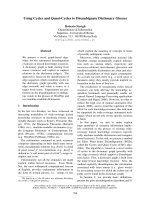Báo cáo khoa học: "USING AN ONLINE DICTIONARY TO FIND RHYMING WORDS AND PRONUNCIATIONS FOR UNKNOWN WORDS " doc
Bạn đang xem bản rút gọn của tài liệu. Xem và tải ngay bản đầy đủ của tài liệu tại đây (459.29 KB, 7 trang )
USING AN ON=LINE DICTIONARY TO FIND RHYMING WORDS
AND PRONUNCIATIONS FOR UNKNOWN WORDS
Roy J Byrd
I.B.M. Thomas J. Watson Research Center
Yorktown Heights, New York 10598
Martin S. Chodorow
Department of Psychology, Hunter College of CUNY
and
I.B.M. Thomas J. Watson Research Center
Yorktown Heights, New York 10598
ABSTRACT
Humans know a great deal about relationships among
words. This paper discusses relationships among word
pronunciations. We describe a computer system which
models human judgement of rhyme by assigning specific
roles to the location of primary stress, the similarity of
phonetic segments, and other factors. By using the
model as an experimental tool, we expect to improve our
understanding of rhyme. A related computer model will
attempt to generate pronunciations for unknown words
by analogy with those for known words. The analogical
processes involve techniques for segmenting and
matching word spellings, and for mapping spelling to
sound in known words. As in the case of rhyme, the
computer model will be an important tool for improving
our understanding of these processes. Both models serve
as the basis for functions in the WordSmith automated
dictionary system.
1. Introduction
This paper describes work undertaken in the develop=
merit of WordSmith, an automated dictionary system
being built by the Lexical Systems group at the IBM T.
J. Watson Research Center. WordSmith allows the user
to explore a multidimensional space of information
about words. The system permits interaction with lexi-
cal databases through a set of programs that carry out
functions such as displaying formatted entries from a
standard dictionary and generating pronunciations for a
word not found in the dictionary. WordSmith also
shows the user words that are "close" to a given word
along dimensions such as spelling (as in published dic-
tionaries), meaning (as in thesauruses), and sound (as in
rhyming dictionaries).
Figure I shows a sample of the WordSmith user inter-
face. The current word,
urgency,
labels the text box at
the center of the screen. The box contains the output
of the PRONUNC application applied to the current
word: it shows the pronunciation of
urgency
and the
mapping between the word's spelling and pronunciation.
PRONUNC represents pronunciations in an alphabet
derived from
Webster's Seventh Collegiate Dictionary.
In
the pronunciation shown "*" represents the vowel
schwa,
and ">" marks the vowel in the syllable bearing
primary stress. Spelling-to-pronunciation mappings will
be described in Section 3.
Three dimensions, displaying words that are neighbors
of
urgency,
pass through the text box. Dimension one,
extending from
uriede
to
urinomerric,
contains words
from the PRONUNC data base which are close to
ur-
gency
in alphabetical order. The second dimension
(from
somebody
to
company)
shows words which are
likely to rhyme with
urgency.
Dimension three (from
9udency
to
pruriency)
is based on a reverse alphabetical
ordering of words, and displays words whose spellings
end similarly to
urgency. The
RHYME and REVERSE
dimensions are discussed below.
277
ureide
uremia
uremic
ureter
ureteral
ureteric
urethan
urethane
urethra
urethrae
urethral
urethritis
urethroscope
urethroscopic
urge
somebody
perfidy
subsidy
burgundy
hypertrophy
courtesy
discourtesy
reluctancy
decumbency
recumbency
incumbency
redundancy
fervency
conservancy
pungency
pudency
agency
subagency
regency
exigency
plangency
tangency
stringency
astringency
contingency
pungency
cogency
emergency
detergency
convergency
l-urgency I
I
N:
>*R-J*N-SE3
I
I u:>* r:R g:d e:*
n:N c:S y:E3
I
i I
urgent
uric
uricosuric
uridine
uriel
urim and thumm
urinal
urinalysis
urinary
urinate
urination
urine
urinogenital
urinometer
urinometric
detergency
surgeoncy
insurgency
convergency
emergency
indeterminacy
pertinency
impertinency
repugnancy
permanency
impermanency
currency
trustworthy
twopenny
company
insurgency
deficiency
efficiency
inefficiency
sufficiency
insufficiency
proficiency
expediency
inexpediency
resiliency
leniency
conveniency
inconvenienc
incipiency
pruriency
APPLICATION: PRONUNC COMMAND:
DIM1: PRONUNC DIM2: RHYME DIM3: REVERSE
DIM4:
Figure 1. WordSmith User Interface.
Section 2 describes the construction of the WordSmith
rhyming dimension, which is based on an encoding pro-
cedure for representing pronunciations. The encoding
procedure is quite flexible, and we believe it can be used
as a research tool to investigate the linguistic and
psycholinguistic structure of syllables and words. Sec-
tion 3 outlines a program for generating a pronunciation
of an unknown word based on pronunciations of known
words. There is evidence (Rosson. 1985) that readers
sometimes generate a pronunciation for an unfamiliar
letter string based on analogy to stored lexical "neigh-
bors" of the string, i.e. actual words that differ only
slightly in spelling from the unfamiliar string. A program
which generates pronunciations by analogy might serve
as a supplement to programs that use spelling-to-sound
rules in applications such as speech synthesis (Thomas,
et aL, 1984), or it might be used to find rhyming words,
in WordSmith's rhyming dimension, for an unknown
word.
Z. Rhyme
The WordSmith rhyme dimension is based on two files.
The first is a main file keyed on the spelling of words
arranged in alphabetical order and containing the words'
pronunciations organized according to part of speech.
This same file serves as the data base for the
PRONUNC application and dimension shown in Figure
1. The second file is an index to the first. It is keyed on
encoded pronunciations and contains pointers to words
in the main file that have the indicated pronunciations.
If a single pronunciation corresponds to multiple
spellings in the main file, then there will be multiple
pointers, one for each spelling. Thus. tiffs index file also
serves as a list of homophones. The order of the en-
coded pronunciations in the index file defines the rhym-
ing dimension so that words which are close to one
another in tiffs file are more likely to rhyme than words
which are far apart.
The original motivation for the encoding used to obtain
the rhyme dimension comes from published reverse dic-
tionaries, some of which (e.g., Walker, 1924) even call
themselves "rhyming dictionaries". Such reverse dic-
tionaries are obtained from a word list by (a) writing the
words right-to-left, instead of left-to-right, (b) doing a
normal alphabetic sort on the reversed spellings, and (c)
restoring the original left-to-right orientation of the
words in the resulting sorted list. This procedure was
used to derive the REVERSE dimension shown in Fig-
ure
I.
There are several problems with using reverse diction=
aries as the basis for determining rhymes. First, since
English spelling allows multiple ways of writing the same
sounds, words that in fact do rhyme may be located far
apart in the dictionary. Second, since English allows a
given spelling to be pronounced in multiple ways, words
that are close to one another in the dictionary will not
necessarily rhyme with each other. Third, the location
of primary stress is a crucial factor in determining if two
words rhyme (Rickert, 1978). Primary stress is not en-
coded in the spelling of words. As an extreme example
of this failure of reverse dictionaries, note that the verb
record
does not rhyme with the noun
record.
Fourth,
basing rhyme on the reverse linear arrangement of let-
ters in words gives monotonically decreasing weight to
the vowels and consonants as one moves from right to
left in the word. This procedure does not capture the
intuition that the vowel in the syllable bearing primary
stress and the vowels following this syllable are more
significant determiners of rhyme than are the conso-
nants. For example, we feel that as a rhyme for
urgency, fervency
would be better than
agency.
A reverse
dictionary, however, would choose the latter. More
specifically, even if the difficulties associated with spell-
ing differences were overcome, a reverse dictionary
would still accord more weight to the /g/ consonant
sound of
agency
than to the /or/ vowel sound of
fervency,
contrary to our intuitions.
t
As already indicated, our procedure uses word pronun-
ciations rather than spellings as the basis for the rhyme
dimension. A total of more than 120,000 pronuncia-
tions from Webster's Seventh Collegiate Dictionary
have been submitted to the encoding process. The first
step in encoding replaces the symbols in the pronuncia-
tion representations with single-byte codes representing
phonetic segments. The procedure which maps seg-
ments to byte codes also allows different segments to
be mapped into a single code, in effect defining equiv-
alence classes of segments. For example, the French u
sound in
brut
is mapped onto the same segment as the
English long u sound in
boot.
This is the same mapping
that most English speakers would make.
In the mapping currently in use, all vowels are organized
linearly according to the vowel triangle. At one end of
the spectrum is the long e sound in
beet
(/i/). At the
other end is the long u sound in
boot
(/u/).
beet i \ /u boot
bit I'~ ./U book
bait e\ / o boat
bat ~e ~/
o
bought
a
pot
The diphthongs are organized into two subseries, one for
rising diphthongs and the other for falling ones. As with
the vowels, each subseries is a linear arrangement of the
diphthongs according to the position of the initial sound
on the vowel triangle. The consonants are similarly or-
ganizod into several subseries. There are voiced and
voiceless stops, voiced and voiceless fricatives and
affricates, nasals, and liquids.
An important point about this mapping from pronun=
elation patterns to phonetic segments is that it is flexible.
Both the phonetic equivalence classes and the collating
sequence can be easily changed. The system can thus
serve as the basis for experimentation aimed at finding
the precise set of phonetic encodings that yield the most
convincing set of rhymes,
270
The second encoding step arranges the segments for a
pronunciation in the order representing theft importance
for determining rhyme. This ordering is also the subject
of continuing experimentation. The current arrange-
ment is as follows:
(1) All segments preceding the syllable bearing pri-
mary stress are recorded in the order that they occur
in the pronunciation string.
(2) All consonantal segments in and following the
syllable beating primary stress are added to the en-
coding in the order in which they occur.
(3) All vocalic segments (vowels and diphthongs) in
and following the syllable bearing primary stress are
placed before any segments for trailing consonants
in the final syllable. [f there are no trailing conso-
nants in the final syllable, then these vocalic seg-
ments are placed at the end of the encoding.
Note that this scheme preserves the order of the seg-
ments preceding the point of primary stress, as well as
those in the final syllable. For words where primary
stress occurs before the final syllable, the vowels are
raised in importance (with respect to rhyming) over all
consonants except final ones. This procedure allows us
to capture the intuition that
fervency
is a better rhyme
for
urgency
than
agency.
The final step in the encoding procedure reverses the
phonetic segment strings right-for-left, groups them ac-
cording to the position of the syllable bearing primary
stress (i.e., the distance of that syllable from the end of
the word) and sorts the groups just as in the production
of reverse dictionaries. The difference is that now
neighbors in the resulting sorted list have a better chance
of rhyming because of the use of pronunciations and the
application of our intuitions about rhymes.
We note that the resulting lists of rhymes are not perfect.
This is so first because we have not completed the ex-
periments which will result in an "optimal" set of int-
uitions about the encoding process. One planned
experiment will clarify the position of the
schwa
vowel
in the vowel triangle. Another will study intervocalic
280
consonant clusters which, especially when they contain
nasals or liquids, result in less successful rhymes. A third
study will allow us to identify "discontinuity" in the
rhyme List, across which rhyming words ate very unlikely
to be found. In Figure 1., a discontinuity seems to occur
between
currency and trustworthy.
The second reason that our rhyme lists ate not perfect
is that it is unlikely that any single dimension will be
sufficient to guarantee that all and only good rhymes for
a given word will appear adjacent to that word in the
dimension's order, if only because different people disa-
gree on what constitutes "good" rhyme.
Examples
We give two sequences of words selected from the
WordSmith RHYME dimension.
antiphonary
dictionary
seditionaty
expeditionary
missionary
These fi,~ words have their primary stress in the forth
syllable from the right, and they also have the same four
vowel sounds from that point onwards. Notice that the
spelling of
antiphonary
would place it quite far from the
others in a standard reverse dictionary. In addition, the
extra syllables at the beginning of
antiphonary,
seditionary,
and
expeditwnary are
irrelevant for deter-
mining rhyme.
write
wright
rite
right
These four words, each a homonym of the others, share
a single record in the rhyming index and are therefore
adjacent in the WordSmith RHYME dimension.
3. Pronunciation of Unknown Words
Reading aloud is a complex psycholinguistic process in
which letter strings ate mapped onto phonetic repres=
entations which, in turn, are converted into articulatory
movements. Psycholinguists have generally assumed
(Forster and Chambers, 1973) that the mapping from
letters to phonemes is mediated by two processes, one
based on rules and the other based on retrieval of stored
pronunciations. For example, the rule
ea
-> /i/ con-
verts the
ea
into the long e sound of
leaf. The
other
process, looking up the stored pronunciation of a word,
is responsible for the reader's rendering of
deaf as/d~f/,
despite the existence of the
ea
->/i/rule. Both proc-
esses are believed to operate in the pronunciation of
known words (Rosson, 1985).
Until recently, it was generally assumed that novel
words or pseudowords (letter strings which are not real
words of English but which conform to English spelling
patterns, e.g
heat')
are pronounced solely by means of
the rule process because such strings do not have stored
representations in the mental lexicon. Hcwever,
Glushko (1979) has demonstrated that the pronuncia-
tion of a pseudoword is influenced by the existence of
lexical "neighbors." i.e., real words that strongly resem-
ble the pseudoword. Pseudowords such as
heal,
whose
closest neighbors
(leaf
and
deaf)
have quite different
pronunciations, take longer to read than pseudowords
such as
hean,
all of whose close neighbors have similar
pronunciations
(dean, lean, mean,
etc.). (It has been
assumed that words which differ only in initial conso-
nants are "closer" neighbors than those which differ in
other segments.) Giushko has also demonstrated an ef-
fect of lexical neighbors on the pronunciation of familiar
words of English.
The picture that emerges from this psychological
work
depicts the retrieval process as selecting all stored words
which are similar to a given input. If the input is not
found in this set (i.e., the input is a novel word or
pseudoword), its pronunciation is generated by analogy
from the pronunciations that are found. Analogical
processing must take note of the substring common to
the input and its neighbors
(ean
in the case of
hean), use
only this part of the pronunciation, and make provision
for pronouncing the substring which is different (h).
When the pronunciations of the lexical neighbors are
consistent, the pronunciation of the pseudoword can be
generated by the reader more quickly than when the
pronunciations are inconsistent.
There are of
course
many unanswered questions about
how readers actually generate pronunciations by anal-
ogy. One approach to answering the questions is to
build a computational system that can use various strat-
egies for finding lexical neighbors, combining partial
pronunciations, etc., and then compare the output of the
system to the pronunciations produced by human read-
ers. The following is an outline of such a computational
system.
Two WordSmith files will be used to support a proposed
program that generates pronunciations for unknown
words based on stored pronunciations of known words.
The fh'st is a main file which is keyed on the spelling of
words and which contains pronunciations organized ac-
cording to part of speech. This is the file which sup-
ported the PRONUNC and RHYME WordSmith
functions described earlier. In this file, each pronuncia-
tion of a word has stored with it a mapping from its
phonetic segments onto the letters of the spelling of the
word. These mappings were generated by a PROLOG
program that uses 148 spelling-to-pronunciation rules
for English (e.g ph ->/f/). The second file is an index
to the main file keyed on reverse spelling. This file is
equivalent to the one which supports the REVERSE
WordSmith dimension shown in Figure I.
The strategy for generating a pronunciation for an un-
known word is to find its lexical neighbors and produce
a pronunciation "by analogy" to their pronunciations.
The procedure is as follows: (a) Segment the spelling of
the unknown word into substrings. (b) Match each sub-
string to part of the spelling of a known word (or
words). (c) Consult the spelling-to-pronunciation map
to find the pronunciation of the substring. (d) Combine
the pronunciations of the substrings into a pronunciation
for the unknown word.
These steps are illustrated below for the unknown word
brange.
(a) Segmentation
brange
<- - • initial substring
< > final substring
Strategies for segmentation will be discussed later.
281
(b) Matching
bran is the
longest initial substring in
brange
that matches a word-initial substring in the dic-
tionary. The word
bran
is a dictionary entry,
and 20 other words begin with this string.
range is the
longest final substring in
brange
that
matches a word-final substring in the diction-
ary. The match is to the word
range.
In the
reverse spelling Fde, 22 other words end in
ange.
(c) Pronunciation of substrings
All 21 words that have the initial string match
for
bran
have the mapping
b r a n
I I I I
b
r aD
n
In 20 of the 23 words that match word-final
ange,
the mapping is
a n
ge
I I I
• n j as in
range(/renj/)
The other three words are
flange
(/aenj/),
or-
ange
(/Inj/), and
melange
(/anj/).
(d) Combining pronunciations
From the substring matches, the pronunciations
of/b/,/r/,/n/,/g/, and/e/are obtained in
a straightforward manner, but pronunciation of
the vowel a is not the same in the
bran
and ange
substrings. Thus, two different pronunciations
emerge as the most likely renderings of
brange.
(i) below is modelled after
range
or
change, and
(ii) is modelled after
bran
or
branch.
(i) brange
IIIII
brenj
(ii) b r a n ge
IIIII
br~nj
Here, pronunciation by analogy yields two
conflicting outcomes depending upon the word
model selected as the lexical neighbor. If peo-
ple use similar analogical strategies in reading,
then we might expect comparable disagree-
ments in pronunciation when they are asked to
read unfamiliar words. A very informal survey
we conducted suggests that there is consider-
able disagreement over the pronunciation of
brange.
About half of those we asked preferred
pronunciation (i), while the others chose (ii).
In the example shown above, segmentation is driven by
the matching process, i.e. the substrings chosen are the
longest which can be matched in the main file and the
reverse spelling f'fle. There are, of course, other possible
strategies of segmentation, including division at syllable
boundaries and division based on the onset-rhyme
structure within the syllable (for
brange, br + angel
Evaluation of these alternative methods must await fur-
ther experimentation.
There are other outstanding questions related to the
Matching and Combining steps. If matches cannot be
found for initial and final substrings that overlap (as in
the example) or at least abut, then information about the
pronunciation of an internal substring will be missing.
Finding a match for an internal substring requires either
a massive indexing of the dictionary by letter position, a
time consuming search of the standard indexes, or the
development of a clever algorithm. With regard to
combining substring pronunciations, the problem of pri-
mary stress assignment arises when primary stress is ab-
sent from all of the substrings or is present at different
locations in two or more of them. Finally, there is a
question of the weight that should be assigned to alter-
native pronunciations generated by this procedure.
Should a match to a high frequency word be preferred
over a match to a low frequency word? Is word fre-
quency more important than the number of matching
substrings which have the same pronunciation? These
are empirical psycholinguistic questions, and the an-
swers will no doubt help us generate pronunciations that
more closely mirror those of native English speakers.
4. Conclusion
The two applications described here, finding rhyming
words and generating pronunciations for unknown
words, represent some ways in which the tools of com-
putational linguistics can be used to address interesting
psycholinguistic questions about the representation of
words. They also show how answer~ to these
psycholinguistic questions can, in turn, contribute to
282
work in computational linguistic.s, in this case to devel-
opment of the WordSmith on-line dictionary.
Acknowledgements
We are grateful to Barbara Kipfer for her preliminary
work on the syllabification of unknown words, and to
Yael Ravin and Mary Neff for comments on earlier ver-
sions of this report.
References
Forster, K. and Chambers, S. (1973), Lexical access and
naming time. Joutmal of Verbal Learning and
Verbal Behavior, 12, 627-635.
Giushko, R. (1979), The organization and activation of
orthographic knowledge in reading aloud. Jour-
nal of Experimental Psychology, 5,674-691.
Rickert, W.E. (1978), Rhyme terms. Style, 12(1),
35-46.
Rosson, M.B. (1985), The interaction of pronunciation
rules and lexical representations in reading
aloud. Memory and Cognition, in press.
Thomas, J., Klavans, J., Nartey, J., Pickover, C., Reich,
D., and Rosson, M. (1984), WALRUS: A de-
velopment system for speech synthesis. IBM
Research Report RC-10626.
Walker, J. (1924), The Rhyming Dictionary, Routledge
and Kegan Paul, London.
Webster's Seventh Collegiate Dictionary (1967),
Merriam, Springfield, Massachusetts.
283
